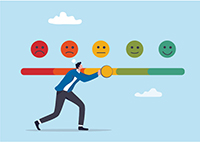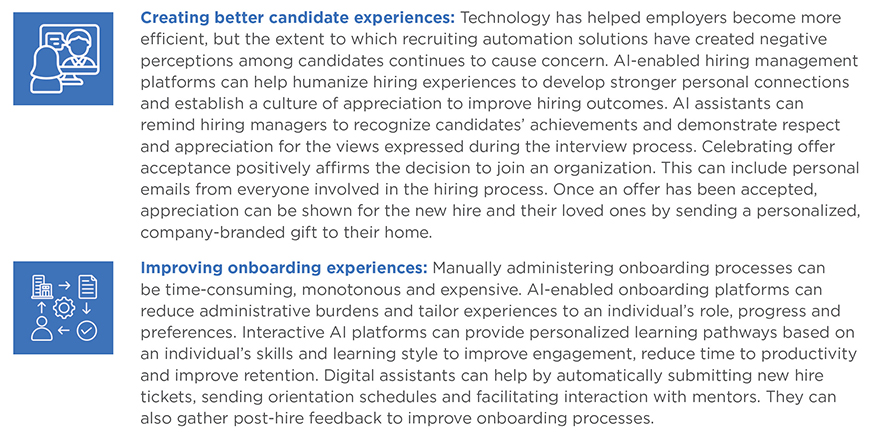How Can AI Transform Employee Recognition?


In the not-too-distant future, employee recognition platforms will expand the use of AI to help managers and peers deliver more personalized and meaningful human interactions that improve engagement, performance and retention.
The following pages present a blueprint for the future of AI-enabled employee recognition experiences.
Download
 hbspt.cta.load(123973, '21153941-4783-4919-89d2-52e4010a0269', {"useNewLoader":"true","region":"na1"});
hbspt.cta.load(123973, '21153941-4783-4919-89d2-52e4010a0269', {"useNewLoader":"true","region":"na1"});
Introduction
 Many leading HR organizations have successfully integrated AI technologies into recruiting processes. AI and machine learning are now also improving recognition experiences. Yet there are important differences between the effective use of AI in recruiting and recognition. In recruiting, AI has proven most successful in helping decision-makers source, screen and evaluate large numbers of candidates. For managers, recognition is not a volume process but a personal expression of appreciation.
Many leading HR organizations have successfully integrated AI technologies into recruiting processes. AI and machine learning are now also improving recognition experiences. Yet there are important differences between the effective use of AI in recruiting and recognition. In recruiting, AI has proven most successful in helping decision-makers source, screen and evaluate large numbers of candidates. For managers, recognition is not a volume process but a personal expression of appreciation.
Given this, one might ask whether using AI in employee recognition makes employees experiences impersonal. While the risk of depersonalization exists (along with legal and regulatory requirements for all AI applications used in HR), AI tools can help HR leaders address several challenges that currently hamper the effectiveness of recognition programs.
We discussed the potential benefits and risks of AI in employee recognition in a recent roundtable session with members of the Trendicators Advisory Board. Engage2Excel s president, Jeff Gelinas, led the discussion, in which he was joined by Dr. Charles Scherbaum, Engage2Excel’s chief analytics officer, and Emily Gatton, senior vice president for sales, solutions and professional services. While many of the advances discussed on the following pages are forward-looking, they represent a blueprint for AI s future in helping managers become more effective at engaging, motivating and recognizing their team members.

Download
 hbspt.cta.load(123973, '21153941-4783-4919-89d2-52e4010a0269', {"useNewLoader":"true","region":"na1"});
hbspt.cta.load(123973, '21153941-4783-4919-89d2-52e4010a0269', {"useNewLoader":"true","region":"na1"});
How Can AI Improve Recognition?
 Employee recognition is a personal expression of appreciation that can improve engagement, enhance individual and team performance and reduce attrition. Managers profoundly influence the practice and effectiveness of employee recognition programs, yet HR leaders often lack the resources to help managers improve their engagement and recognition skills. The following provides a high-level overview of how AI can address these challenges.
Employee recognition is a personal expression of appreciation that can improve engagement, enhance individual and team performance and reduce attrition. Managers profoundly influence the practice and effectiveness of employee recognition programs, yet HR leaders often lack the resources to help managers improve their engagement and recognition skills. The following provides a high-level overview of how AI can address these challenges.

Download
 hbspt.cta.load(123973, '21153941-4783-4919-89d2-52e4010a0269', {"useNewLoader":"true","region":"na1"});
hbspt.cta.load(123973, '21153941-4783-4919-89d2-52e4010a0269', {"useNewLoader":"true","region":"na1"});
Experiential & Regulatory Risks
 This publication focuses on the future use of AI in recognition systems, for which the growth of AI tools in the workforce provides an important context. A May 2024 survey by Microsoft found that 75% of knowledge workers use AI, and 46% of users began using it less than six months ago. However, using AI in HR support functions poses unique challenges and risks, which are described in the following overview of the hurdles that recognition platform providers and their customers must overcome.
This publication focuses on the future use of AI in recognition systems, for which the growth of AI tools in the workforce provides an important context. A May 2024 survey by Microsoft found that 75% of knowledge workers use AI, and 46% of users began using it less than six months ago. However, using AI in HR support functions poses unique challenges and risks, which are described in the following overview of the hurdles that recognition platform providers and their customers must overcome.

Download
 hbspt.cta.load(123973, '21153941-4783-4919-89d2-52e4010a0269', {"useNewLoader":"true","region":"na1"});
hbspt.cta.load(123973, '21153941-4783-4919-89d2-52e4010a0269', {"useNewLoader":"true","region":"na1"});
Improving Manager Effectiveness
 Today, recognition platforms operate largely outside the realm of the tools and applications managers and their teams use to accomplish their work. The next wave of AI innovation is called agentic AI. While generative AI chatbots, copilots and suggestion engines assist users with specific tasks, they are largely reactive, responding to user input based on a predefined logic. In contrast, agentic AI systems are proactive, acting autonomously to plan ahead. They can adapt to new challenges by using internal models, learning algorithms and decision-making processes to navigate and interact with various sources of input and applications. Agentic AI systems will be used within enterprises to manage and improve financial operations, customer service, procurement, cybersecurity, payroll processing, data management, regulatory compliance and risk mitigation processes.
Today, recognition platforms operate largely outside the realm of the tools and applications managers and their teams use to accomplish their work. The next wave of AI innovation is called agentic AI. While generative AI chatbots, copilots and suggestion engines assist users with specific tasks, they are largely reactive, responding to user input based on a predefined logic. In contrast, agentic AI systems are proactive, acting autonomously to plan ahead. They can adapt to new challenges by using internal models, learning algorithms and decision-making processes to navigate and interact with various sources of input and applications. Agentic AI systems will be used within enterprises to manage and improve financial operations, customer service, procurement, cybersecurity, payroll processing, data management, regulatory compliance and risk mitigation processes.
In recognition, generative and agentic AI systems can work together as intelligent assistants to help managers build strong, genuine connections with employees. The following scenarios illustrate some of the ways AI can be used to improve manager effectiveness.

Download
 hbspt.cta.load(123973, '21153941-4783-4919-89d2-52e4010a0269', {"useNewLoader":"true","region":"na1"});
hbspt.cta.load(123973, '21153941-4783-4919-89d2-52e4010a0269', {"useNewLoader":"true","region":"na1"});
Reducing Early Attrition
 Recruiting and onboarding experiences play a vital role in influencing early attrition rates. While recognition program owners are not always directly involved in supporting these processes, they should help coordinate experiences throughout the talent lifecycle. Participants in Engage2Excel s 2024 Trendicators Job Seeker Survey reported that the demonstration of respect, recognition and appreciation during the hiring process had the greatest influence on their decision to accept or reject a job offer.
Recruiting and onboarding experiences play a vital role in influencing early attrition rates. While recognition program owners are not always directly involved in supporting these processes, they should help coordinate experiences throughout the talent lifecycle. Participants in Engage2Excel s 2024 Trendicators Job Seeker Survey reported that the demonstration of respect, recognition and appreciation during the hiring process had the greatest influence on their decision to accept or reject a job offer.
The survey also revealed that 65% of respondents said the first day of their onboarding experience is likely or highly likely to affect their decision to stay at a company for more than a month. Furthermore, 63% stated that their overall onboarding experience would influence their decision to remain for more than a year.
The following is an overview of how AI can help improve hiring and onboarding experiences to maximize your organization s talent advantage in today s highly competitive employment environment.
Download
 hbspt.cta.load(123973, '21153941-4783-4919-89d2-52e4010a0269', {"useNewLoader":"true","region":"na1"});
hbspt.cta.load(123973, '21153941-4783-4919-89d2-52e4010a0269', {"useNewLoader":"true","region":"na1"});
Key Takeaways
Our client advisors unanimously agreed on current challenges regarding improving managers effectiveness in delivering positive and more personally relevant recognition experiences. They also concurred that incorporating AI into recognition practices will require careful planning to ensure the accuracy of system training data, as well as collaboration with senior leadership and IT, legal and procurement teams to align with enterprise strategies and policies for the governance of AI. These quotes summarize the insights and feedback from advisors.
“As with all new technologies, adoption will be key. It has always been a challenge for recognition program managers to influence the day-to-day behaviors of managers. The ability of new systems to function as co-pilots or intelligent assistants during daily interactions could be a real game changer.”
“There are so many important things behind the scenes that are impossible for managers to keep up with in addition to their other responsibilities. Automating data-driven insights and suggestions will help managers do a better job of engaging and motivating their teams, and also free recognition program managers to focus their efforts on analyzing and optimizing program impacts.”
“The use of predictive analytics is particularly appealing. The ability to track behaviors and document business outcomes will be very beneficial in helping to identify the areas of our enterprise that are using recognition exceptionally well and where additional coaching is needed.”
Download
 hbspt.cta.load(123973, '21153941-4783-4919-89d2-52e4010a0269', {"useNewLoader":"true","region":"na1"});
hbspt.cta.load(123973, '21153941-4783-4919-89d2-52e4010a0269', {"useNewLoader":"true","region":"na1"});

